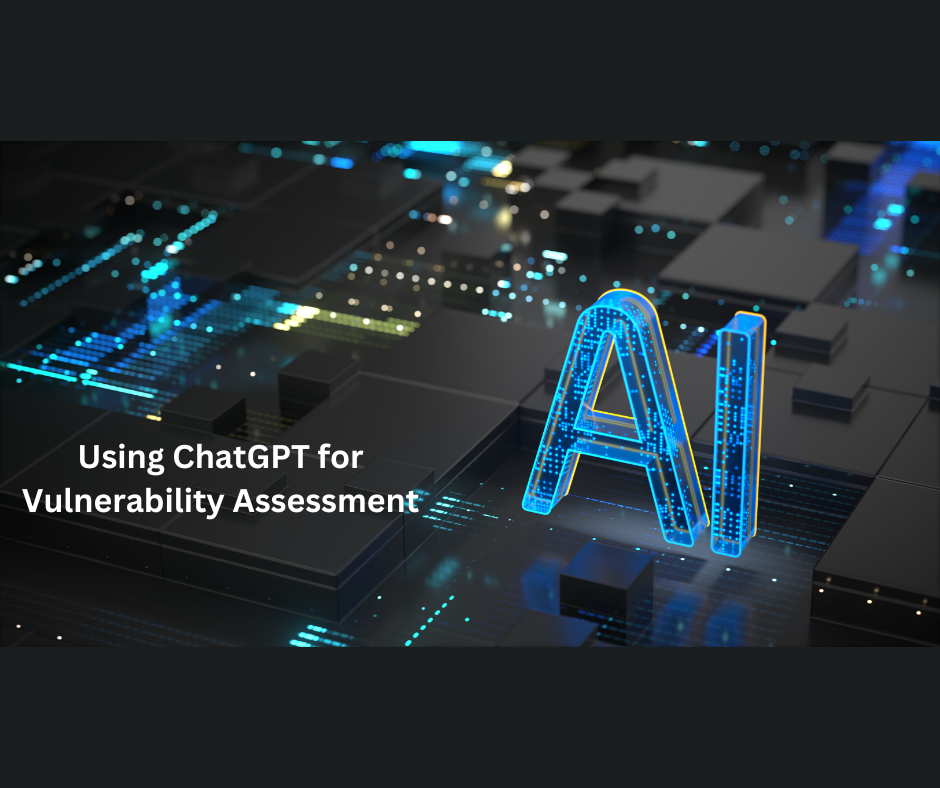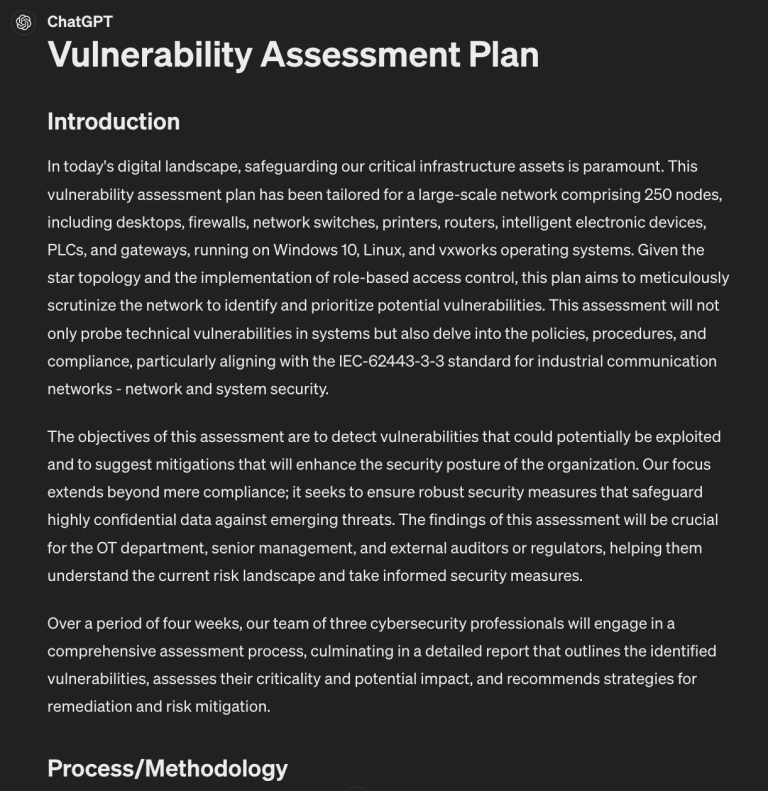Creating a Vulnerability Assessment Plan using ChatGPT

Brief about ChatGPT
ChatGPT, a sophisticated language model crafted by OpenAI, excels in producing context-sensitive responses and materials tailored to user prompts. This model harnesses the capabilities of generative artificial intelligence to interpret and deliver intelligent answers to a diverse array of questions. Its versatility makes it an indispensable resource in various fields, notably in cybersecurity applications.
Generative AI is a branch of artificial intelligence (AI) that uses machine learning (ML) algorithms and natural language processing (NLP) to analyze patterns and structures within a dataset and
generate new data that resembles the original dataset. LLMs are a type of generative AI that are trained on massive amounts of text data, enabling them to understand context, generate human-like responses, and create content based on user input.
GPT stands for Generative Pre-Trained Transformer and, as the name suggests, is an LLM that has been pre-trained to improve accuracy and/or provide specific knowledge-based data generation.
ChatGPT has sparked debates regarding plagiarism within academic circles and content creation communities. Additionally, it has been associated with misinformation and social engineering efforts, attributed to its capacity to produce realistic, human-like text. Despite these concerns, the transformative potential of such technology across multiple industries is undeniable. Specifically, large language models (LLMs) demonstrate considerable promise in technical domains like programming and cybersecurity. These models leverage their extensive knowledge base to perform intricate tasks, including instant data analysis and coding of fully operational software.
Vulnerability Assessment
Vulnerability Assessment is an essential part of any organization’s security strategy. It involves identifying, classifying, and prioritizing vulnerabilities in computer systems, networks, and software to understand the potential threats to an organization’s security. A thorough vulnerability assessment plan helps in systematically evaluating the security of systems against known vulnerabilities, ensuring that the defensive measures are not only in place but also effective.
In this blog, I try to explore using using ChatGPT for creating vulnerability assement plans, a crucial part of any cybersecurity strategy.
In later subsequent blogs I will delve into using ChatGPT in conjunction with the MITRE ATT&CK framework, a globally accessible knowledge base of adversary tactics and techniques.
Creating Vulnerability Assessment Plans
This guide functions like a recipe, teaching you to utilize the capabilities of ChatGPT for devising thorough vulnerability assessment plans, drawing on network, system, and business information as inputs. In my view, this methodology is invaluable, catering to cybersecurity students and novices eager to master the appropriate techniques and tools for vulnerability assessments. It is equally beneficial for seasoned cybersecurity professionals looking to streamline the planning and documentation process.
You will also learn to craft precise prompts that yield well-structured output in Markdown language. This guide serves as a hands-on manual for creating detailed and effective vulnerability assessment plans using ChatGPT.
How to do it…
Let me walk you through the process of using ChatGPT to create a comprehensive vulnerability assessment plan tailored to a specific network and organization’s needs. By providing the necessary details and using the given system role and prompt, you will be able to generate a well-structured assessment plan:
- Begin by logging in to your ChatGPT account and navigating to the ChatGPT web UI.
- Start a new conversation with ChatGPT by clicking the New chat button.
- Enter the following prompt to establish a system role:
You are a cybersecurity professional specializing in vulnerability assessment.
- Enter the following message text, but replace the placeholders in the { } brackets with the appropriate data of your choice. You can either combine this prompt with the system role or enter it separately as follows:
Using cybersecurity industry standards, regulations and best practices, create a complete and detailed assessment plan (not looking for a penetration test) that includes: Introduction, outline of the process/methodology, required tools, and a very detailed multi-layered outline of the steps involved. Provide a thorough and descriptive introduction and as much detail and description as possible throughout the plan. The plan should not be the only assessment of technical vulnerabilities on systems but also policies, procedures, and compliance. It should include the use of scanning tools as well as configuration review, operation & maintenance staff interviews, and production/manufacturing site walk-around. All recommendations should follow industry standard best practices and methods. The plan should be a minimum of 2000 words.
Create the plan so that it is specific for the following details:
Network Size: {Large}
Number of Nodes: {250}
Type of Devices: {Desktops, Firewalls, Network Switches, Printers, Routers, Intelligent Electronic Devices, PLC’s, Gateways}
Specific systems or devices that need to be excluded from the assessment: {None}
Operating Systems: {Windows 10, Linux, vxworks}
Network Topology: {Star}
Access Controls: {Role-based access control}
Previous Security Incidents: {No incidents in the last year}
Compliance Requirements: {IEC-62443-3-3}
Business Critical Assets: {Critical Infrastructure Assets}
Data Classification: {Highly confidential}
Goals and objectives of the vulnerability assessment: {To identify and prioritize potential vulnerabilities in the network and provide recommendations for remediation and risk mitigation}
Timeline for the vulnerability assessment: {4 weeks}
Team: {3 cybersecurity professionals, including a vulnerability assessment lead and two security analysts}
Expected deliverables of the assessment: {A detailed report outlining the results of the vulnerability assessment, including identified vulnerabilities, their criticality, potential impact on the network, and recommendations for remediation and risk mitigation}
Audience: {The organization’s OT department, senior management, and any external auditors or regulators}
Provide the plan using the following format and markdown language:
#Vulnerability Assessment Plan
##Introduction
Thorough Introduction to the plan including the scope, reasons for doing it, goals and objectives, and summary of the plan
##Process/Methodology
Description and Outline of the process/Methodology
##Tools Required
List of required tools and applications, with their descriptions and reasons needed
##Assessment Steps
Detailed, multi-layered outline of the assessment steps
- Review the generated output from ChatGPT. If the output is satisfactory and meets the requirements, you can proceed to the next step. If not, you can either refine your prompt or rerun the conversation to generate a new output.
- Once you have obtained the desired output, you can use the generated Markdown to create a well-structured vulnerability assessment plan in your preferred text editor or Markdown viewer.
- Figure below shows an example ChatGPT generation of a vulnerability assessment plan using Markdown language formatting.

Picture credit – ChatGPT Output
How it works…
This blog on creating a vulnerability assessment plan with GPT assistance harnesses the advanced capabilities of natural language processing (NLP) and machine learning (ML) technologies. By incorporating a detailed system role and a comprehensive user request into the prompt, ChatGPT customizes its responses to suit the sophisticated needs of an experienced cybersecurity professional tasked with evaluating a large network system.
Here’s an overview of how this process is implemented:
- System Role and Detailed Prompt: ChatGPT assumes the role of an expert in vulnerability assessment. The prompt acts as a comprehensive user request, detailing the scale of the network, types of devices involved, compliance requirements, and expected deliverables. This specificity provides the necessary context to guide ChatGPT’s responses, ensuring they meet the demands of a complex vulnerability assessment.
- NLP and ML Technology: The foundation of ChatGPT’s functionality lies in its use of NLP and ML. These technologies enable the model to grasp the nuances of the user’s request, identify patterns, and produce a detailed, precise, and actionable vulnerability assessment plan.
- Knowledge and Language Understanding: Utilizing its vast knowledge base and language comprehension skills, ChatGPT adheres to industry-standard methodologies and best practices. This adherence is crucial in the dynamic field of cybersecurity, ensuring that the generated vulnerability assessment plans are both current and in line with established standards.
- Markdown Language Output: The output in Markdown format ensures that the assessment plan is consistently well-organized and readable. This is essential for integrating the plan into reports, presentations, and other formal documentation needed by IT/OT departments, senior management, and external stakeholders like auditors or regulators.
- Streamlining the Assessment Planning Process: Employing this GPT-powered approach to vulnerability assessment planning significantly streamlines the creation of comprehensive plans. It saves time in planning and documentation while delivering a professional-grade assessment plan that conforms to industry standards and meets the specific requirements of your organization.
By leveraging these detailed inputs, ChatGPT transforms into an effective tool that aids in the creation of a comprehensive, customized vulnerability assessment plan. This not only enhances your cybersecurity initiatives but also ensures efficient use of resources in safeguarding your network systems.
Summary
Incorporating AI into your cybersecurity strategy not only streamlines processes but also enriches them, providing deeper insights and more effective security solutions. Embrace the power of AI with ChatGPT, and fortify your vulnerability assessment plans to safeguard your digital assets against the ever-growing landscape of cyber threats.
Disclaimer: “The views expressed in this post are my own and do not necessarily reflect the views or positions of my organization.”
